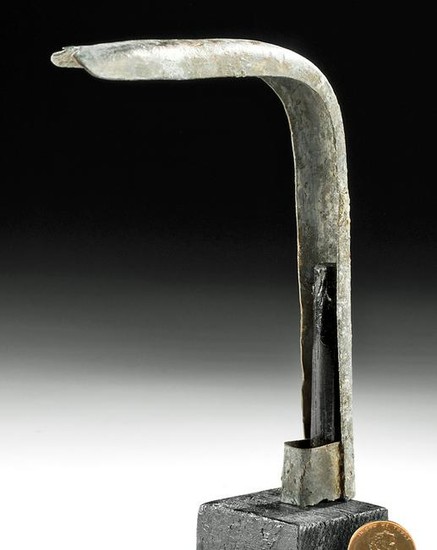Late Roman / Byzantine Brass Strigil
Roman to Byzantine, ca. 4th to 6th century CE. A wonderful strigil created from a single brass sheet with a wide, its form presenting a concave blade that curved and tapers to a rounded end. The blade straightens out to a slender handle with folded sides to create a receptacle to attach a handle. The entire tool is covered in green and brown patina. The strigil was a scraper used by athletes in combination with olive oil and sand or pumice to exfoliate the skin after exercising or bathing. It was an essential piece of equipment for the typical Greek and Roman athlete, and as such came to symbolize athleticism itself. Size: 4.875" W x 5.375" H (12.4 cm x 13.7 cm); 5.75" H (14.6 cm) on included custom stand.
Greek visual culture abounds with depictions of youthful athletes using strigils in the gymnasium. The celebrated sculpture by Lysippos entitled the Apoxyomenos (ca. 350 to 325 BCE), for example, depicts a nude athlete scraping himself off with a strigil.
Provenance: private J.H. collection, Beaverton, Oregon, USA; ex-Time Machine Co., Flushing, New York, USA
All items legal to buy/sell under U.S. Statute covering cultural patrimony Code 2600, CHAPTER 14, and are guaranteed to be as described or your money back.
A Certificate of Authenticity will accompany all winning bids.
We ship worldwide to most countries and handle all shipping in-house for your convenience.
#150211
Condition Report: Losses to tip and nicks peripheries of the body, as well as peripheries of the folded section at the lower end. The entire tool is covered in green and brown patina that has developed over the ages.
View it on
Estimate
Time, Location
Auction House
Roman to Byzantine, ca. 4th to 6th century CE. A wonderful strigil created from a single brass sheet with a wide, its form presenting a concave blade that curved and tapers to a rounded end. The blade straightens out to a slender handle with folded sides to create a receptacle to attach a handle. The entire tool is covered in green and brown patina. The strigil was a scraper used by athletes in combination with olive oil and sand or pumice to exfoliate the skin after exercising or bathing. It was an essential piece of equipment for the typical Greek and Roman athlete, and as such came to symbolize athleticism itself. Size: 4.875" W x 5.375" H (12.4 cm x 13.7 cm); 5.75" H (14.6 cm) on included custom stand.
Greek visual culture abounds with depictions of youthful athletes using strigils in the gymnasium. The celebrated sculpture by Lysippos entitled the Apoxyomenos (ca. 350 to 325 BCE), for example, depicts a nude athlete scraping himself off with a strigil.
Provenance: private J.H. collection, Beaverton, Oregon, USA; ex-Time Machine Co., Flushing, New York, USA
All items legal to buy/sell under U.S. Statute covering cultural patrimony Code 2600, CHAPTER 14, and are guaranteed to be as described or your money back.
A Certificate of Authenticity will accompany all winning bids.
We ship worldwide to most countries and handle all shipping in-house for your convenience.
#150211
Condition Report: Losses to tip and nicks peripheries of the body, as well as peripheries of the folded section at the lower end. The entire tool is covered in green and brown patina that has developed over the ages.




